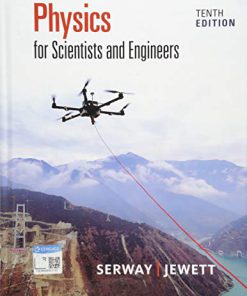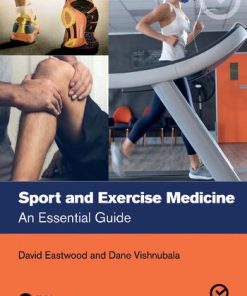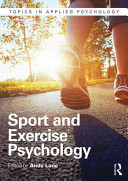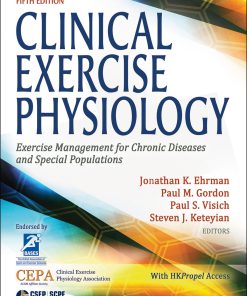Nutrition for Sport and Exercise 5th Edition by Marie Dunford, Andrew Doyle 0357448154 9780357448151
$50.00 Original price was: $50.00.$25.00Current price is: $25.00.
Nutrition for Sport and Exercise 5th Edition by Marie Dunford, Andrew Doyle – Ebook PDF Instant Download/Delivery: 0357448154, 9780357448151
Full download Nutrition for Sport and Exercise 5th Edition after payment

Product details:
ISBN 10: 0357448154
ISBN 13: 9780357448151
Author: Marie Dunford; J. Andrew Doyle
Translate current nutrition recommendations and guidelines into specific plans. Dunford/Doyle’s NUTRITION FOR SPORT AND EXERCISE, 5th Edition helps you select the appropriate type of foods, beverages and/or supplements you need to support training, performance and recovery. This practical book emphasizes the scientific basis for sports nutrition recommendations and highlights current research studies of trained athletes from a variety of sports. Detailed explanations of the connection between exercise and nutrition help you reach your ultimate goals–optimal performance and health. Entire chapters are devoted to diet planning, disordered eating, exercise patterns in athletes, and achieving lifelong fitness and health.
Nutrition for Sport and Exercise 5th Table of contents:
Chapter 1. Introduction to Sports Nutrition
1.1. Training, Nutrition, and the Athlete
Sports Nutrition Is a Blend of Exercise Physiology and Nutrition
The Term Athlete is Very Broad and Inclusive
Physical Activity, Exercise, and Sport Differ from Each Other
Training and Nutrition Go Hand in Hand
Nutrition Supports Training, Recovery, and Performance
It Is Important to Understand Basic Training Principles
In Addition to a Training Plan, an Athlete Needs a Nutrition Plan
1.2. Basic Nutrition Standards and Guidelines
The Dietary Reference Intakes (DRI) Is a Standard Used to Assess Nutrient Intake
The Dietary Guidelines for Americans Provide Basic Dietary and Exercise Advice
MyPlate Is a Tool that Can Be used to help Consumers Implement the Dietary Guidelines
A Food Pyramid Has Been Developed for Athletes
Several Other Meal-Planning Tools Are also Available
The Nutrition Facts Label Provides Specific Nutrition Information
1.3. Basic Sports Nutrition Guidelines
The Demands of an Athlete’s Sport Must Be Carefully Considered
1.4. Dietary Supplements and Ergogenic Aids
Dietary Supplement Health and Education Act
Many Products Fall Under the Umbrella Known as Dietary Supplements
Dietary Supplement Use among Athletes Is High
Athletes Consume Supplements for Many Reasons
Knowledge of a Supplement’s Legality, Safety, Purity, and Effectiveness Is Crucial
1.5. Understanding and Evaluating Scientific Evidence
There Are Three Basic Types of Research Studies
The Basis of Good Research Is Strong Research Design and Methodology
Peer Review Is an Important Safeguard in the Publication of Scientific Research
Levels of Evidence and Grades of Recommendations Put the Scientific Body of Literature in Perspective
Conclusions from Scientific Studies Can Be Misinterpreted
Much of the Nutrition-, Exercise-, and Health-Related Information on the Internet Is Inaccurate
1.6. Exercise and Nutrition Credentials and Certifications
There Are Many Types of Practitioners in the Area of Exercise Science
Many Types of Practitioners Work in the Area of Nutrition
Scope of Practice Helps Establish Professional Boundaries
Summary
Self-Test
Chapter 2. Defining and Measuring Energy
2.1. Energy and Energy Concepts
Energy Is the Ability to Perform Work
High-Energy Phosphate Compounds Store and Release Energy
2.2. Measuring Energy
The Energy Content of Food Is Measured by Calorimetry
The Amount of Energy Expended Can Be Measured Directly or Indirectly
2.3. Concepts of Energy Balance
Energy Intake Is Estimated by Analyzing Daily Food and Beverage Consumption
Components of Energy Expenditure Can Be Estimated by Different Methods
Estimated Energy Requirement Is a Daily Balance of Energy Intake and Expenditure
Summary
Self-Test
Chapter 3. Energy Systems and Exercise
3.1. Overview of Energy Systems
ATP Is Rephosphorylized from ADP
3.2. The Creatine Phosphate Energy System
Creatine Is Consumed in the Diet or Synthesized in the Body from Amino Acids
The Creatine Phosphate Energy System Phosphorylates ADP to ATP Rapidly
Rephosphorylation of Creatine Phosphate from Creatine Depends on Aerobic Metabolism
3.3. The Anaerobic Glycolysis Energy System
Glycolysis Uses the Energy Contained in Glucose to Rephosphorylate ATP from ADP
Lactate Is Metabolized Aerobically
3.4. The Oxidative Phosphorylation Energy System
Carbohydrates Are Oxidized in the Krebs Cycle
The Electron Transport Chain Uses the Potential Energy of Electron Transfer to Rephosphorylate ADP to ATP
3.5. Fuel Utilization
Fats Are Metabolized Aerobically by the Oxidation of Fatty Acids
Proteins Are Metabolized Aerobically by the Oxidation of Amino Acids
The Respiratory Exchange Ratio (RER) Indicates Utilization of Carbohydrate and Fat as Fuels
Dietary Intake Influences Carbohydrate, Fat, and Protein Metabolism
Metabolism Is Influenced by the Fed-Fast Cycle
The Fed State Favors Nutrient Storage
Total Energy Intake Is an Important Factor
3.6. Oxygen Consumption
Increased Use of Aerobic Metabolism Results in an Increase in Oxygen Consumption
Each Individual has a Maximal Ability to Consume Oxygen, or V ˙ o 2 max
Oxygen Consumption and V ˙ o 2 max are Influenced By a Variety of Factors
Summary
Self-Test
Chapter 4. Carbohydrates
4.1. Carbohydrates in Food
Carbohydrates Are Classified in Different Ways
4.2. Digestion, Absorption, and Transportation of Carbohydrates
Glucose and Fructose Are Absorbed by Different Mechanisms
Carbohydrate Is Transported as Blood Glucose
4.3. Metabolism of Glucose in the Body
Blood Glucose Is Carefully Regulated
Glucose Can Be Metabolized Immediately for Energy
Glucose Can Be Stored as Glycogen for Later Use
Products of Glucose Metabolism Can Be Used to Synthesize Fatty Acids
Glucose Can Be Produced from Lactate, Amino Acids, and Glycerol by a Process Called Gluconeogenesis
4.4. Carbohydrates as a Source of Energy for Exercise
Exercising Muscle First Uses Carbohydrate Stored as Glycogen
Exercising Muscle Takes up and Metabolizes Blood Glucose
Exercise Training Increases the Capacity for Carbohydrate Metabolism
Glucose Metabolism During Exercise Is Controlled by Hormones
Exercise Intensity Affects Carbohydrate Metabolism
4.5. Carbohydrate Recommendations for Athletes
Daily Carbohydrate Intake Is Based on Individual Needs to Meet the Long-Term Demands of Training and Competition
Athletes Need to Plan Their Carbohydrate Intake Before, During, and After Training and Competition
Muscle Glycogen Stores Can Be Maximized by Diet and Exercise Manipulation
Training and Performance may Be Impaired If Insufficient Carbohydrate Is Consumed
Carbohydrate and Fiber Must Be Consumed in Appropriate Amounts for Good Health
4.6. Translating Daily Carbohydrate Recommendations to Food Choices
A Carbohydrate-Rich Diet Requires Planning
Diet Planning for Carbohydrate Intake Must Consider Practical Issues
Summary
Self-Test
Chapter 5. Proteins
5.1. Structure and Function of Protein
Amino Acids Form the Basic Structure of Proteins
Some Amino Acids Cannot Be Manufactured by the Body and Must Be Provided by Food
Proteins Vary in Quality Due to the Amount and Types of Amino Acids Present
The Structure of a Protein Determines Its Function
Proteins Perform Many Functions in the Body
5.2. Digestion, Absorption, and Transportation of Protein
Proteins Are Digested in the Stomach and Small Intestine
Proteins Are Absorbed in the Small Intestine
After Absorption, Some Amino Acids Are Transported to the Liver, Whereas Others Circulate in the Blood
5.3. Metabolism of Proteins and Amino Acids
The Body Uses Amino Acids to Build Proteins, a Process Known as Anabolism
The Body Breaks Down Proteins into Amino Acids, a Process Known as Catabolism
Protein Is Metabolized During Endurance Exercise
Amino Acid Breakdown Produces Ammonia
The Body Is Constantly Breaking Down Proteins as Well as Building Proteins
Skeletal Muscle Protein Synthesis and Immune System Function Are Influenced By Many Factors
5.4. Protein Recommendations for Athletes
Recommended Ranges for Protein Intake by Athletes Are Good Guidelines But Should Be Individualized for Each Athlete
Timing of Protein Intake Is Important, Especially after Exercise
Most Athletes Consume a Sufficient Amount of Protein, But Some Consume a Low or Excessive Amount
Some Practical Problems Are Associated with Consuming an Excessive Amount of Protein
5.5. Effect of Energy Intake on Protein Intake
Long-Term, Substantial Energy Deficits Typically Result in Low Protein Intake
Long-Term, Small Energy Deficits Are Characteristic of a Pattern of Eating for Some Athletes
Intermediate-Term, Daily Energy Deficits (“Dieting”) May Lead to Loss of Lean Body Mass
Short-Term, Substantial Energy Deficits Are Used to “Make Weight,” But Such Diets Can Have Detrimental Effects
Some Athletes Engage in Short-Term, Intermittent Fasting
Low Protein Intake Negatively Affects the Immune System
5.6. Translating Protein Intake Recommendations to Practical, Daily Food Choices
Well-Planned Vegetarian and Vegan Diets Are Healthful and Nutritionally Adequate
Protein Supplements Should Be Considered a Part of an Athlete’s Overall Protein Intake
5.7. Supplementation with Individual Amino Acids
Beta-Alanine May Help to Buffer Muscle pH in High-Intensity (Sprint) Exercise
β-Hydroxy-β-Methylbutyrate (HMB) Has Some Anticatabolic Properties
Branched Chain Amino Acids (BCAA) May Help to Support Immune Function in Endurance Athletes
Glutamine Supplementation Does Not Appear to Be Effective as a Way to Enhance the Functioning of the Immune System
Glucosamine/Chondroitin Sulfate Is Generally Not Effective for Reducing Joint Pain
Growth Hormone Releasers, Particularly Arginine, May Be Effective for Stimulating the Release of Growth Hormone
Nitric Oxide (NO)/Arginine Alpha-Ketoglutarate (AAKG) Reduces Oxygen Cost of Exercise and Improves Exercise Tolerance
Summary
Self-Test
Chapter 6. Fats
6.1. Fatty Acids, Sterols, and Phospholipids
Fatty Acids Vary Due to Their Chemical Compositions
Most Fats in Food Are in the form of Triglycerides
Two Essential Fatty Acids cannot Be Manufactured by the Body
Omega-3 Fatty Acids have many Beneficial Effects
Omega-3 Fatty Acids may have a Role in Recovery from Strenuous Exercise
Sterols, such as Cholesterol, and Phospholipids Are Types of Fat Found in Foods
Some Fats Lower the Risk for Heart Disease
6.2. Digestion, Absorption, and Transportation of Fats
Fat Is Digested Primarily in the Small Intestine
After Being Absorbed, the Fatty Acids Are Resynthesized into Triglycerides
The Transportation of Fats into the Blood Is a Slow Process
6.3. Storage and Metabolism of Fats
Fat Can Be Easily Stored in the Body
Fat Is an Important Source of Energy for many Athletes
6.4. Fats as a Source of Energy During Exercise
It Is Important to Know the Relative (Percentage) and Absolute Amount of Fat Utilized as a Fuel
The Body Adapts to Endurance Exercise Training by Improving its Ability to Metabolize Fat
6.5. Fat Recommendations for Athletes
Total Daily Fat Intake Depends on Total Energy, Carbohydrate, and Protein Intakes
Reducing Caloric Intake by Reducing Dietary Fat Intake over Several Weeks or Months may Help Athletes Achieve a Loss of Body Fat
Inadequate Fat Intake Can Negatively Affect Training, Performance, and Health
6.6. Translating Daily Fat Recommendations to Food Choices
The Amount and Type of Fat in Foods Varies
The Typical American Diet Is Usually Too High in Fat for an Athlete in Training
There Are Ways to Modify the Typical American Diet so It Is Lower in Fat
Some foods are made with fat substitutes
6.7. Fat-Related Dietary Supplements
Caffeine Is a Central Nervous Stimulant That Helps to Delay Fatigue
Summary
Self-Test
Chapter 7. Water and Electrolytes
7.1. Overview of Water and Electrolytes
The Amount of Water in the Body Depends on Many Factors
Body Water Is Distributed as Intracellular or Extracellular Fluid
7.2. Water Loss, Intake, Balance, and Imbalance
Water Is Lost in a Variety of Ways
Water Is Added to the Body Primarily through the Intake of Beverages and Foods
There Are Constant Changes in Body Water, Resulting in Temporary Water Imbalances
7.3. Effect of Exercise on Fluid Balance
Exercise Can have Dramatic Effects on Water Loss, Particularly due to Sweating
Core Temperature Is Affected by Hydration Status
Excessive Dehydration may Impair Exercise Performance
Electrolyte Loss, Particularly Sodium Loss, During Exercise Can Be Substantial
Exercise-Related Muscle Cramping, Often Associated with Dehydration or Electrolyte Loss, may have Other Causes
7.4. Strategies to Replenish Water and Electrolytes
Hydration Status should Be Assessed and Monitored
General Guidelines Have Been Developed for the Type, Timing, and Amount of Fluids and Electrolytes Consumed Before, During, and after Exercise
Each Athlete should Develop an Individualized Plan for Choosing Foods and Beverages That Meet Fluid and Electrolyte Needs
In the Process of Replenishing Fluids and Electrolytes, Athletes may Be Consuming other Nutrients
Hyponatremia, or Plasma Sodium being Too Low, Is a Serious Electrolyte Disturbance That Can Be Fatal
Increasing Fluid Levels above Normal Is Hyperhydration
Summary
Self-Test
Chapter 8. Vitamins
8.1. Classification of Vitamins
A Recommended Daily Intake Has Been Established for Each Vitamin
Moderate to Rigorous Exercise May Increase the need for Some Vitamins, but the Increase Is Small
Poor Food Choices by Athletes and Sedentary People Often Lead to Low Vitamin Intake
It Is Important to Guard against Both Vitamin Deficiencies and Toxicities
8.2. The Roles of Vitamins in the Body
Some of the B-Complex Vitamins Are Associated with Energy Metabolism
Some Vitamins have Antioxidant Properties that Help Protect Cells from Damage
Vitamins with Antioxidant Properties Are Found in Both Food and Supplements
Vitamin B 12 and Folate are Two Vitamins Associated with Red Blood Cell Function
Many Vitamins Are Associated with Growth and Development, Including Vitamins A and D
8.3. Sources of Vitamins
Each Person must Decide the Best Ways to Obtain an Adequate Amount of Vitamins
The Vitamin Content of a Diet Can Vary Tremendously based on the Amounts and Types of Food Consumed
Vitamins Are Added to Many Foods Marketed to Athletes
The Dose and Potency of a Vitamin Supplement Can Vary Substantially from Brand to Brand
Summary
Self-Test
Chapter 9. Minerals
9.1. Classification of Minerals
A Recommended Daily Intake Has Been Established for Many Minerals
Moderate to Rigorous Exercise Increases the Loss of Some Minerals
Poor Food Choices by Athletes and Sedentary People Often Lead to Low Mineral Intake
9.2. Mineral Deficiencies and Toxicities
Many Factors Influence Mineral Absorption
It Is Important to Guard Against Mineral Deficiencies
Mineral Toxicities Are Rare But Possible
9.3. The Roles of Minerals in Bone Formation
Bones have both Structural and Metabolic Functions
Achieving Peak Bone Mineral Density Is Critical to Long-Term Health
Bone Loss Is Associated with Aging
Calcium may Be Taken from Bone to Maintain Calcium Homeostasis
Bone Loss Is Associated with Lack of Estrogen
The Roles of Calcium and Exercise in Preventing or Reducing Bone Loss Associated with Aging Have not Been Fully Established
It Is Important to Meet the Recommended Dietary Intakes for Calcium and Vitamin D
Many People Consume an Inadequate Amount of Calcium Daily
There Are Numerous Strategies for Increasing Dietary Calcium Consumption
Phosphorus, Fluoride, and Magnesium Are also Involved with Bone Health
9.4. The Roles of Minerals in Blood Formation
Iron Is an Integral Part of Hemoglobin
Blood Tests Can Help Detect Iron Deficiency
Athletes may Develop Iron Deficiency and Iron Deficiency Anemia
Iron Deficiency and Iron Deficiency Anemia Negatively affect Performance
Several Factors Affect Iron Status in Athletes, Particularly Endurance and Ultraendurance Athletes
Athletes Should Consume a Variety of Iron-Containing Foods
9.5. The Roles of Minerals in the Immune System
The Immune System Protects the Body from Disease
9.6. The Adequate Intake of All Minerals
The Key to Obtaining all the Minerals Needed from Food Is to Consume a Nutrient-Dense, Whole-Foods Diet
The Dose and Potency of a Mineral Supplement Can vary Substantially from Brand to Brand
Summary
Self-Test
Chapter 10. Diet Planning: Food First, Supplements Second
10.1. Energy: The Basis of the Diet-Planning Framework
A Dietary Prescription Helps Athletes Consume the Proper Amount of Carbohydrates, Proteins, and Fats within Their Energy Needs
Consuming Nutrient-Dense Foods Is the Key to Eating Nutritiously without Consuming Excess Calories
10.2. Translating Nutrient Recommendations into Food Choices
Each Athlete Should have an Individualized Diet Plan
Food Intake Needs to Be Distributed Appropriately Throughout the Day
10.3. Diet Plans Popular with Athletes
Vegetarian or Vegan Diet
Paleolithic (“Paleo”) Diet
Gluten-Free Diet
Low-Carbohydrate High-Fat (LCHF) Diet
10.4. The Risks and Benefits of Caffeine and Alcohol Consumption
Many Athletes Consume Caffeine Safely and Effectively as a Central Nervous System Stimulant
Athletes Should Consider the Risks and Benefits of Alcohol Consumption
10.5. Dietary Supplements and Ergogenic Aids
For Those Supplements That Are Known to Be Effective, the Ability to Enhance Performance Is Relatively Small
NCAA Bylaws Regarding Banned Substances and Non–Muscle-Building Nutritional Supplements
Practitioners Should Discuss Dietary Supplement Use with Athletes
Vitamin and Mineral Supplements Are Frequently used by Athletes
Protein Supplements Are Particularly Popular with High School and Collegiate Male Athletes
Probiotic Supplements may Improve Gastrointestinal and Immune Functions in Athletes
Athletes Typically Consume Herbals and Botanicals to Prevent or Recover from Illness or Injury
10.6. A Comprehensive Nutrition Plan to Support Training and Performance
Assessment
Summary
Self-Test
Chapter 11. Weight and Body Composition
11.1. Understanding Weight and Body Composition
It Is Important to Understand the Concepts of Body Mass, Weight, and Composition
11.2. Assessment and Interpretation of Weight and Body Composition
Body Weight Is Measured with a Scale
Body Composition Can Be Estimated by a Variety of Methods
Underwater Weighing and Plethysmography Estimate Body Composition by Determining Body Density
Body Composition Can Be Estimated Using the Thickness of Skinfolds from Specific Sites on the Body
Bioelectrical Impedance Analysis (BIA) Uses Electrical Currents to Estimate the Proportion of Fat in the Body
A Beam of Near-Infrared Light Is Used to Distinguish Between Fat and Other Tissues
Dual-Energy X-Ray Absorptiometry (DEXA or DXA) Uses Low-Intensity, Focused X-Rays to Determine Bone Density and Estimate Body Composition
Advanced Imaging Techniques Include CT Scans, MRI, and Ultrasound
Body Composition Results Must Be Interpreted Appropriately
Body Weight Results Must Be Interpreted Appropriately and Used Consistently
11.3. Body Composition and Weight Related to Performance
Certain Physical Characteristics Are Associated with Sports Performance
Many Athletes Establish Weight and Body Composition Goals in an Effort to Improve Performance or Health
11.4. Changing Body Composition to Enhance Performance
Desired Body Composition Can Be Used to Determine a Target Weight
Body Composition Can Be Changed by Increasing Muscle Mass
Body Composition Can Be Changed by Decreasing Body Fat
Increasing Muscle Mass While Decreasing Body Fat Is Difficult
Body Composition Changes May Be Seasonal
Athletes Who Compete in Lightweight Sports Push the Biological Envelope
Underweight Athletes May Need to Increase Muscle Mass and Body Fat
11.5. Supplements Used to Change Body Composition
Supplements Are Often Used to Help Increase Muscle Mass
Supplements Are Often Used to Assist Weight Loss
Citrus Aurantium (Bitter Orange) May Be Used in Supplements Advertised as Ephedra-Free
Conjugated Linoleic Acid (CLA) Is Marketed to Athletes as a Way to Change Body Composition and Improve Performance
Athletes Should Be Cautious about Using Weight-Loss and Muscle-Building Supplements
Summary
Self-Test
Chapter 12. Disordered Eating and Exercise Patterns in Athletes
12.1. Case Study: Disordered Eating and Eating Disorders
Case Study: Carmen, a Cross-Country Runner
12.2. Overview of Eating and Exercise Patterns
“Normal” Eating Is Flexible
Disordered Eating Is Not the Same as an Eating Disorder
Eating Disorders Are Psychiatric Diseases
Anorexia Athletica Describes an Eating Disorder Unique to Athletes
Obsessive-Compulsive Disorder and Disordered Eating May Be Intertwined
Some People Suffer from Exercise Dependence and Voluntarily Engage in Excessive Exercise
12.3. Disordered Eating and Eating Disorders in Athletes
The Prevalence of Disordered Eating and Eating Disorders Is Difficult to Determine
Some Sports Have a Higher Prevalence of Disordered Eating and Eating Disorders
More Information Is Emerging about Eating Disorders in Males
Disordered Eating Behaviors May Progress to an Eating Disorder
It Is Important to Distinguish “Normal” and Dysfunctional Eating and Exercise Behaviors in Athletes
Ultimately, Eating Disorders Have a Negative Effect on Performance and Health
If Disordered Eating or an Eating Disorder Is Suspected, Then the Athlete Should Be Approached with Care and Concern
It Is Important to Promote a Culture That Supports “Normal” Eating for all Athletes
12.4. Energy Availability, Female Athlete Triad, and Relative Energy Deficiency in Sport (RED-S)
Low Energy Availability Is a Major Factor in Performance and Health
The Female Athlete Triad Raised Awareness of Potential Problems in Athletes
Amenorrhea Is the Absence or Suppression of Menstruation
Low Bone Mineral Density Is a Factor Involved in the Female Athlete Triad
Both Elite and Recreational Athletes Can Develop the Female Athlete Triad
The Relative Energy Deficiency in Sport (RED-S) Is a Proposed Extension to the Female Athlete Triad
Prevention, Intervention, and Treatment of Low Energy Availability Are Critical
Summary
Self-Test
Chapter 13. Diet and Exercise for Lifelong Fitness and Health
13.1. The Lifelong Athlete
Most Collegiate Athletes do not Become Professional Athletes and Must Adjust to Reduced Exercise Training
Various Nutrition and Exercise Guidelines are Remarkably Similar, Although There Are Some Differences
13.2. The Impact of Overweight and Obesity on Chronic Diseases
The Majority of Americans Are Overweight or have Obesity
Regulation of Body Weight is a Complex Process That Is Not Completely Understood
The Treatment of Overweight and Obesity Involves Long-Term Changes to Established Food and Exercise Patterns
13.3. Diet, Exercise, and Chronic Disease
Diet and Exercise Are Associated with the Prevention and Treatment of Hypertension
Diabetes Is a Group of Diseases Characterized by a High Blood Glucose Level
Diet and Physical Activity Play Critical Roles in the Management of Type 2 Diabetes
Cardiovascular Disease Is the Major Cause of Death in the United States
Metabolic Syndrome Is a Cluster of Metabolic Disorders Strongly Associated with Abdominal Obesity and Insulin Resistance
Osteoporosis Is Characterized by Low Bone Mineral Density
Many Cancers Are Related to Lifestyle
Chronic Disease Risk Can Be Assessed with a Number of Screening Tools
Physical Activity and Fitness may Reduce the Adverse Impact of Overfatness on Health
The Health at Every Size Movement Emphasizes Improved Metabolic Health Over Weight and Fat Loss
Behavior Change Is Needed to Prevent and Treat Lifestyle-Related Chronic Diseases
Summary
Self-Test
Appendix A. Dietary Reference Intakes (DRI) for Energy and Macronutrients
Appendix B. Healthy U.S.—Style Pattern: Recommended Intake Amounts
Appendix C. Healthy Vegetarian Pattern: Recommended Intake Amounts
Appendix D. Sample 24-Hour Food Intake Form
Appendix E. Sample 24-Hour Physical Activity Log
Appendix F. The Compendium of Physical Activities
Appendix G. Percentile Values for Maximal Aerobic Power ( ml ⋅ kg – 1 ⋅ min – 1 ) *
Appendix H. Respiratory Exchange Ratio (RER)
Appendix I. Anaerobic Glycolysis, the Krebs (Tricarboxylic Acid) Cycle, and the Electron Transport Chain
Appendix J. Beta-Oxidation of Fatty Acids
Appendix K. Body Mass Index (BMI)
Appendix L. Normative Values for Percent Body Fat for Adult Men and Women by Decade
Appendix M. Evidence-Based Recommendations for Exercise
Appendix N. The DASH (Dietary Approaches to Stop Hypertension) Eating Plan at Various Calorie Levels
Appendix P. References
Appendix Q. Dietary Reference Intakes (DRI) and Common Conversion Factor
People also search for Nutrition for Sport and Exercise 5th:
sports nutrition for young athletes pdf
sports and exercise nutrition fifth edition
nutrition for sport exercise and health free pdf
max fit sports nutrition
Tags:
Marie Dunford,Andrew Doyle,Nutrition,Sport
You may also like…
Hobbies & Games - Training & Coaching
Physiology of Sport and Exercise 7th Edition W. Larry Kenney
Uncategorized
High Impact Teaching for Sport and Exercise Psychology Educators 1st Edition John E. Coumbe-Lilley
Physics - Physics of the Atmosphere
Physics for Scientists and Engineers (MindTap Course List) 10th Edition Serway
Medicine - Others
Sport and Exercise Medicine: An Essential Guide David Eastwood
Hobbies & Games - Training & Coaching
Hobbies & Games - Training & Coaching
Sport and Exercise Psychology 2nd Edition by Andrew Michael Lane 9781848722248 1848722249
Medicine - Anatomy and physiology
Uncategorized











